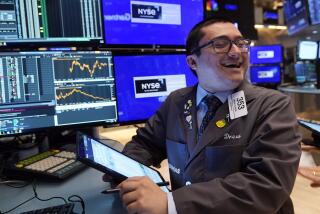Regulators unable to explain Dow’s 700-point fall
Reporting from Washington — Federal regulators working around the clock have yet to pinpoint the cause of last week’s rapid stock market plunge, but they’ve learned enough to propose changes to prevent a repeat, Securities and Exchange Commission Chairwoman Mary Schapiro said Tuesday.
The SEC and the Commodity Futures Trading Commission are sifting through records of the 66 million trades — 17 million during the most volatile hour alone — last Thursday, when the Dow Jones industrial average plummeted 700 points in just 15 minutes.
Schapiro said the two agencies had found no so-called fat-finger error, one in which a trader improperly entered an order for billions of shares rather than millions of shares, but said they could not yet “definitely rule that possibility out.”
Nor did they find anything to indicate that other rumored causes — a hacker or terrorist group or unusual trading in Procter & Gamble stock or other stocks — were behind the nose dive, Schapiro told the House capital markets subcommittee.
Ultimately, the cause could be “the result of a confluence of events,” she said. Regulators have issued subpoenas for information, and preliminary findings should be available next week.
“While we don’t know all the causes of the volatility, we do know what some of the symptoms were and we can go ahead and tackle those,” Schapiro said. “We run the risk of losing investor confidence if we don’t fix some of the things we believe … are a problem.”
The SEC is working to develop new circuit-breaker rules across increasingly fragmented exchanges and on individual stocks to prevent rapid market dives by imposing a uniform pause or halt in trading. The SEC also wants exchanges to contribute data about their trades to a consolidated audit trail to help regulators more quickly determine the cause of market gyrations.
Lawmakers said they were concerned that technological advances, such as high-speed computerized trading, have made markets more volatile and difficult to control.
“A ghost-in-the-machine scenario in which an enormous computer sell-off sparks a vicious cycle of selling and panic seems completely plausible,” said Rep. Paul Kanjorski (D-Pa.), the subcommittee chairman. “To thwart this doomsday hypothetical, regulators must act with great speed and great care to promulgate new rules.”
He lamented losses by average investors, citing a story about a couple who lost $100,000 during the market dive because their trade cleared at the wrong time. House Financial Services Committee Chairman Barney Frank (D-Mass.) said regulators needed to look at compensation for those investors.
Rep. Brad Sherman (D-Sherman Oaks) criticized the computer-driven practice known as high-frequency trading and suggested a small tax on such trades to make them less attractive.
But lawmakers, particularly Republicans, warned that regulators need to be careful not to stifle improvements brought by technology, such as less-expensive trading and more competitive markets.
Still, Rep. Spencer Bachus (R-Ala.) said Thursday’s brief stock plunge had given the SEC “the political clout it needs to take action to help insulate the market from a technological meltdown.”
The New York Stock Exchange put circuit breakers in place after the 1987 market crash. But Thursday’s drop did not trigger the thresholds, which require at least a 10% drop in the Dow before 2:30 p.m. EDT or at least a 20% drop after 2 p.m. EDT.
The agreement Schapiro reached Monday with the heads of the NYSE, Nasdaq and other exchanges calls for a lower threshold, tying the mechanism to the Standard & Poor’s 500 index and halting trading across all markets, Eric Noll, Nasdaq’s executive vice president, told the subcommittee.
A drop of 5% would trigger a 15-minute trading halt, a 10% drop would halt trading for an hour and a 20% drop would stop trading for the rest of the day.
More to Read
Inside the business of entertainment
The Wide Shot brings you news, analysis and insights on everything from streaming wars to production — and what it all means for the future.
You may occasionally receive promotional content from the Los Angeles Times.











